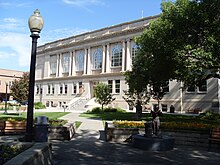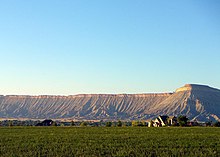Grand Junction, Colorado
| Grand Junction | |
|---|---|
 Downtown Grand Junction |
|
| Location of Grand Junction in Colorado | |
| Basic data | |
| Foundation : | July 22, 1882 |
| State : | United States |
| State : | Colorado |
| County : | Mesa County |
| Coordinates : | 39 ° 5 ′ N , 108 ° 34 ′ W |
| Time zone : | Mountain ( UTC − 7 / −6 ) |
| Residents : | 63,374 (as of 2018) |
| Population density : | 794.2 inhabitants per km 2 |
| Area : | 80.5 km 2 (approx. 31 mi 2 ) of which 79.8 km 2 (approx. 31 mi 2 ) are land |
| Height : | 1397 m |
| Postcodes : | 81501-81506 |
| Area code : | +1 970 |
| FIPS : | 08-31660 |
| GNIS ID : | 0204662 |
| Website : | www.gjcity.org |
| Mayor : | Rick Taggart |
Grand Junction is located in Mesa County in the US state of Colorado , United States . The city has 63,374 inhabitants (as of 2018) with a catchment area of 80.5 km² and is the seat of the county administration. The city is managed as the Home Rule Municipality . Several localities located near Grand Junction in the Grand Valley contribute to the city's trade and commerce.
| Grand Junction, Colorado | ||||||||||||||||||||||||||||||||||||||||||||||||
|---|---|---|---|---|---|---|---|---|---|---|---|---|---|---|---|---|---|---|---|---|---|---|---|---|---|---|---|---|---|---|---|---|---|---|---|---|---|---|---|---|---|---|---|---|---|---|---|---|
| Climate diagram | ||||||||||||||||||||||||||||||||||||||||||||||||
| ||||||||||||||||||||||||||||||||||||||||||||||||
geography
According to the data of the United States Census Bureau , the place has an area of 80.5 km² , of which 79.8 km² consists of land and 0.7 km² (= 0.87%) consists of water. Grand Junction lies at an altitude of 1,463 m in the middle of the Grand Valley , a fertile valley in the course of the Colorado River . The city is on the north bank of the river, across from the mouth of the Gunnison River . Both are named after the Grand River , as the upper reaches of the Colorado were called until 1921. The Indians from the Ute tribe used to settle in this valley . The area is rich in natural resources such as oil, uranium and vanadium.
climate
The region has a semi-arid continental climate . Summer is usually warm and dry - the highest daily temperature was recorded on July 21, 2005 at 41 ° C, the average daily highs are around 33 ° C; the average daily low temperature is around 17 ° C, precipitation is rather rare in the summer months. Due to this warm mountain climate, fruit (apples, pears, peaches) and vegetables thrive here, and even some wineries have settled here.
The winters are mostly mild with light snowfalls; the fallen snow thaws away very quickly. Temperatures fluctuate between −5 and 15 ° C, but can drop to −20 ° C.
Economic history
After the arrival of the first settlers in the 1880s, agriculture and livestock were the main economic activities in the city and its surroundings. This continued until significant reserves of petroleum were discovered at Parachute in the Piceance Basin in the 1960s . The various embargoes imposed for political reasons led to higher oil prices . This increased interest in the exploitation of these deposits and eventually Exxon secured much of the mining rights in the area. The company selected Grand Junction as its headquarters. Grand Junction became the largest city in the region.
Grand Junction and the Grand Valley prospered from oil production in the 1970s and early 1980s. In western Colorado, crude oil occurs primarily as oil shale and can only be extracted uneconomically when oil prices are low. May 2, 1982, known as “Black Sunday” , initiated Exxon's withdrawal from the region and caused the region's economy to collapse. The President of Exxon informed then- Governor of Colorado Richard Douglas Lamm that Exxon would end its losses in the region, but would retain the production rights for the then and now ineligible oil reserves. The bursting of an economic bubble was felt across the state as Exxon had previously invested more than $ 5 billion ( $ 13 billion when adjusted for inflation) in Colorado.
Colorado historian Tom Noel believes that the bursting of that bubble “was definitely a turning point, and that it was a reminder that [Colorado] was a booming and bursting state ... There were parallels with the silver crash of 1893. “ Others drew parallels to the dreams of the atomic age, when Rocky Flats near Denver was considered Colorado's piggy bank in 1955 . The production of fuel rods for nuclear power plants was foreseen around the world. In fact, Rocky Flats later mainly produced warheads for atomic bombs . Much of the uranium that the United States needed for its nuclear weapons program was mined at Grand Junction and then processed in Rocky Flats. From 1913 to 1925, Colorado was the largest producer of uranium in the United States. Although larger deposits were discovered in other states before the 1950s, Colorado remained the largest supplier of fissile material until the height of the US nuclear weapons program in the 1960s.
Today's Grand Junctions economy stands on a broader basis. Aside from tourism , agriculture and services , energy companies have reinvested in oil mining in recent years.
Transport links
The Interstate 70 connects Grand Junction east of Glenwood Springs and the 317 km distant federal state capital Denver , west with the state of Utah . The US Highway 6 runs in Grand Junction parallel to Interstate 70. The US Highway 50 connects Grand Junction with Montrose , Gunnison and Pueblo .
In the north of the city is the Grand Junction Regional Airport - Walker Field Airport, a regional airport from which various destinations in the USA are regularly served.
The local train station, Grand Junction Station , is connected to an east-west rail link. National passenger train operator Amtrak serves Grand Junction in both directions with the California Zephyr , a daily train service between Union Station (Chicago) , Illinois and Emeryville , California on the San Francisco Bay .
education
Grand Junction has four high schools (integrated comprehensive schools). The largest and best-known high school is the Central High School, which also organizes a student exchange with the Saxon high school St. Augustin in Grimma every two years . The competing Grand Junction High School (GJHS for short) maintains the student exchange with the Bavarian high school in Markt Indersdorf . The Colorado Mesa University has its main campus in Grand Junction.
Attractions
The main attraction is the nearby Colorado National Monument . Additional points of interest include the Dinosaur Valley Museum, the Western Colorado Botanical Gardens, and the Museum of Western Colorado.
Grand Junction is the starting point of the Dinosaur Diamond Prehistoric Highway , a 512 mile (824 km) circuit through Colorado and Utah that is part of the National Scenic Byways . It is also an ideal starting point for white water trips on the Gunnison River.
In the city is the Museum of Western Colorado with various exhibitions on the history of the area. You can see rock carvings by the Ute Indians and a uranium mine. Attached is the Sterling T Smith Educational Tower . From the viewing platform on the roof you have a good overview of the city and the surrounding geological attractions.
Demographics
At the time of the United States Census 2000, Grand Junction was inhabited by 58,556 people. The population density was 526.2 people per km ². There were 18,784 housing units at an average of 235.4 per km ². The Grand Junctions population was 91.78% White , 0.60% Black or African Americans , 0.94% Native Americans , 0.76% Asians , 0.12% Pacific Islanders , and 3.81% believed to be of other races and 1.99% named two or more races. 10.86% of the population declared to be Hispanic or Latino .
The residents of Grand Junctions were distributed to 17,865 households out of which 25.5% had children under the age of 18. 46.1% of households were married, 9.4% had a female head of the household without a husband, and 41.0% were not families. 33.2% of households were made up of individuals and someone lived in 13.8% of all households aged 65 years or older. The average household size was 2.23 and the average family size was 2.84 people.
The population was divided into 21.2% minors, 11.9% 18–24 year olds, 26.3% 25–44 year olds, 22.8% 45–64 year olds and 17.9% aged 65 years or more. The median age was 39 years. For every 100 women there were 95.1 men. For every 100 women over the age of 18, there were 92.6 men.
The median household income in Grand Junction was 33,152 US dollars and the median family income reached the amount of 43,851 US dollars. The median income for men was $ 31,685 compared to $ 22,804 for women. The per capita income was $ 19,692. 11.9% of the population and 7.5% of families had an income below the poverty line , including 11.8% of minors and 9.0% of those aged 65 and over.
Personalities
sons and daughters of the town
- Elmo Smith (1909–1968), politician and 27th Governor of Oregon
- Roger Dashen (1938–1995), theoretical physicist
- Marilyn Ferguson (1938-2008), writer
- Natalie Bieser (* 1948), contemporary painter and object artist
- Christa Campbell (born 1972), actress
- Ben Hoffman (* 1983), triathlete, six-time Ironman winner
- Ben Garland (born 1988), football player
- Rebecca Ward (* 1990), saber fencer
Individual evidence
- ↑ a b c Grand Junction city, Colorado. In: factfinder.census.gov. United States Census Bureau , accessed February 22, 2020 .
- ↑ Richard Williamson: Oil shale collapse preserved scenic vistas. In: denver.rockymountainnews.com. Denver Rocky Mountain News October 5, 1999, archived from the original June 27, 2009 ; accessed on February 22, 2020 (English).
- ↑ Our Story. In: museumofwesternco.com. Museums of Western Colorado, accessed February 22, 2020 .





